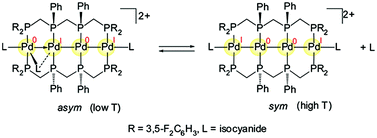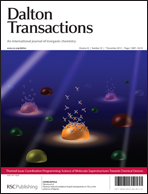Flexible, linear, tetranuclear palladium complexes supported by tetraphosphine ligands with electron-withdrawing groups†
Abstract
A linearly ordered tetraphosphine containing electron-withdrawing substituent groups on the outer phosphorus atoms, meso-bis[{di(3,5-difluorophenyl)phosphinomethyl}phenylphosphino]methane (dpmppmF2), was prepared and reacted with [Pd2(RNC)6](PF6)2 and Pd(dba)2 to afford tetranuclear palladium complexes, [Pd4(μ-dpmppmF2)2(RNC)3](PF6)2 (R = 2,6-xylyl (Xyl) (1), 2,4,6-mesityl (2), 2,6-diisopropylphenyl (3) and tert-butyl (4)), which involve an asymmetric {(RNC)Pd4(CNR)2}2+ core supported by two dpmppmF2 ligands in anti-arrangement. Each terminal of the Pd4 chain was capped by terminal isocyanide and a semi-bridging RNC is introduced into one terminal Pd site. Mechanistic investigation suggested that the dipalladium(I) complex, [Pd2(μ-dpmppmF2)2(RNC)2](PF6)2 (R = Xyl (6)), was a key intermediate to trap Pd0 species by the uncoordinated outer phosphine pendants with electron-withdrawing groups. Variable-temperature UV-vis and 31P{1H}, 1H NMR spectroscopic studies demonstrated that the tetrapalladium complexes are quite fluxional in the solution state at high temperature (>20 °C) relating to a symmetric structure of [Pd4(μ-dpmppmF2)2(RNC)2](PF6)2, and the asymmetric solid state structures are retained even in the solution at low temperature (<−60 °C). Theoretical calculations with DFT methods on the asymmetric (R = Xyl (1)) and symmetric (R = Xyl (1′)) structures suggested that contribution of Pd0→PdI–Pd0–PdI with 60 cluster valence electrons (CVEs) would be dominant in 1, while the symmetric structure of 1′ can be recognized as PdI–Pd0–Pd0–PdI with 58 CVEs. The new tetraphosphine dpmppmF2 was proven very effective in organizing dynamically flexible tetrapalladium chains.

- This article is part of the themed collection: Coordination Programming: Science of Molecular Superstructures Towards Chemical Devices

 Please wait while we load your content...
Please wait while we load your content...